
Is German Volume Training (10×10) Good for Gaining Muscle Size?
German volume training (GVT), also knows as the ten sets method, is commonly used during bulking phases as a way to increase muscle growth. But how does it compare against a more traditional bulking approach? Do those extra sets really stimulate extra muscle growth?
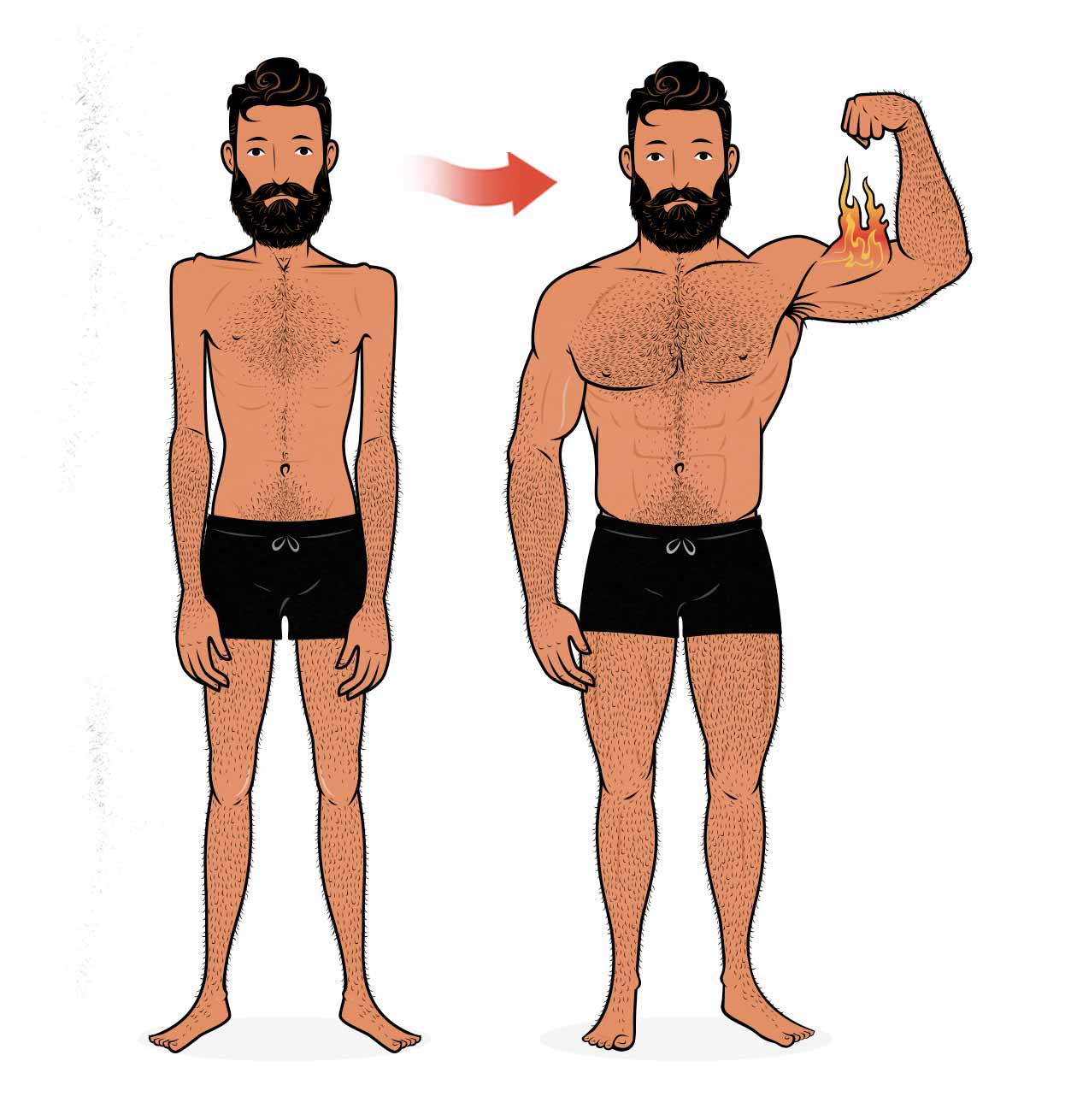
What is German Volume Training?
German Volume Training (GVT) is a high-volume approach to hypertrophy training that involves doing 10 sets of 10 repetitions. 10×10. It’s like 5×5 strength training except done for twice as many reps and for twice as many sets. The idea is to accumulate more training volume to stimulate more muscle growth.

It isn’t one specific program but rather a bulking technique that was used by German weightlifters during their off-seasons. The idea was to train with higher volumes when they weren’t competing, allowing them to gain more muscle size. Those bigger muscles would give them a greater strength potential that they could develop during their competition season.
When German Volume Training was brought into the United States, it was popularized by Vince Gironda, Charles Poliquin, and, more recently, Jeff Cavaliere (Athlean-X). Each of them has slightly different guidelines, but Poliquin’s were perhaps the most popular. He recommends the following:
- Training volume: 10 sets per exercise.
- Rep range: 10 repetitions per set.
- Rest times: 60 seconds between sets.
- Load: 60% of your 1-rep max (a load you can do 20 reps with).
- Lifting tempo: lift slowly (2 seconds), lower very slowly (4 seconds).
- Exercise selection: one big compound exercise for each muscle group.
- Training frequency: each muscle is trained every 4-5 days (low frequency).
- Progression: when you can complete all 10 reps for all 10 sets, increase the load by 4–5%.
German Volume Training recommends using short 60-second rest periods between sets. For some lifts, such as barbell curls, short rest periods are fairly reasonable. For other lifts, such as squats and deadlifts, it doesn’t leave much time for our cardiovascular systems and muscles to recover, and thus our performance tends to decrease from set to set. To solve that problem, we’re usually advised to use our 20-rep max (60% of our 1-rep max) for all ten sets. This makes the first few sets fairly easy, thus making it possible to complete all ten sets without hitting muscle failure or needing to strip weight off the bar.
For exercise selection, the idea is to use big compound lifts, such as the squat, bench press, deadlift, overhead press, and chin-up. Because we’re doing so many sets of the big compound lifts, we don’t have much room in our routine for smaller isolation lifts, but they’re sometimes added in with a lower volume of, say, 3 sets of 10 repetitions.
Sample German Volume Training Workout Program
For an idea of what German Volume Training looks like in practice, we can take a look at the training program used in a recent study.
Workout 1
- Bench press (main lift): 10 sets of 10 repetitions with 60% of 1RM.
- Lat pulldown (main lift): 10 sets of 10 repetitions with 60% of 1RM.
- Incline bench press: 4 sets of 10 repetitions with 70% of 1RM.
- Seated row: 4 sets of 10 repetitions with 70% of 1RM.
- Crunches: 3 sets of 20 repetitions to just shy of failure.
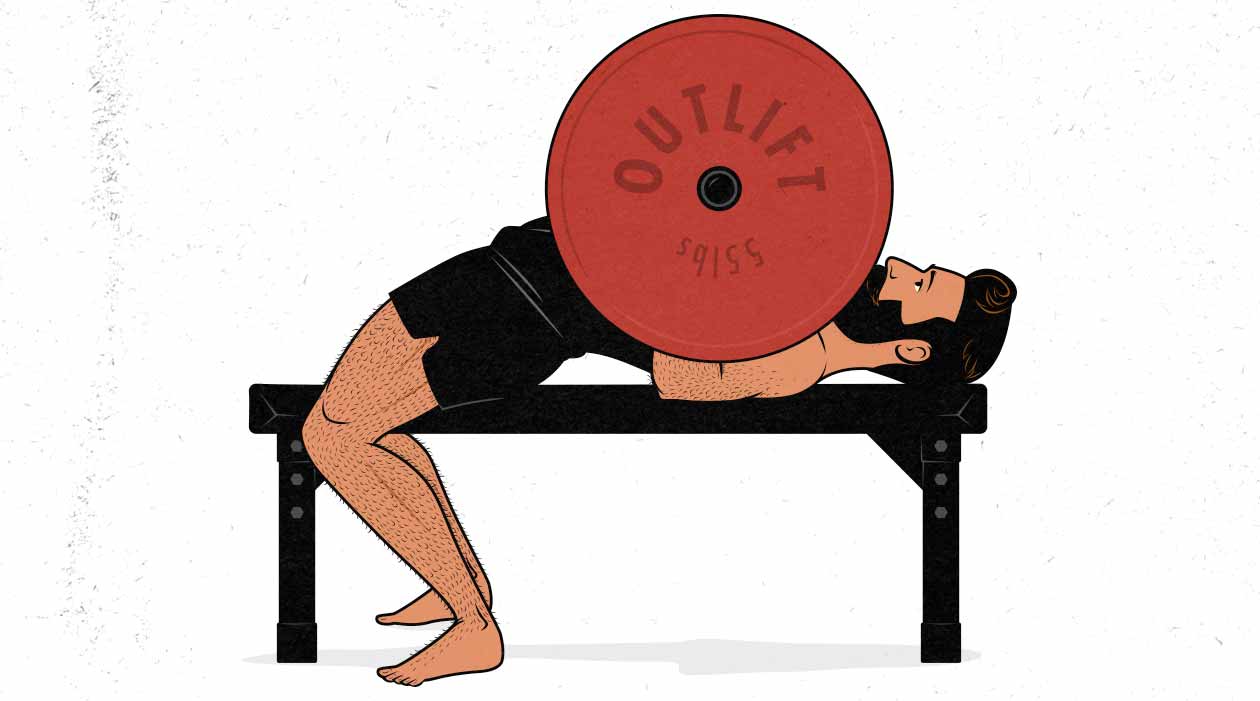
The final set of each exercise is taken all the way to failure. Whenever the participants were able to do the prescribed number of repetitions on that final set, the load was increased by 5–10%.
Workout 2
- Leg Press (main lift): 10 sets of 10 repetitions with 60% of 1RM.
- Dumbbell lunges (main lift): 10 sets of 10 repetitions with 70% of 1RM.
- Leg extensions: 4 sets of 10 repetitions with 70% of 1RM.
- Leg curls: 4 sets of 10 repetitions with 70% of 1RM.
- Calf raises: 3 sets of 20 repetitions to just shy of failure.
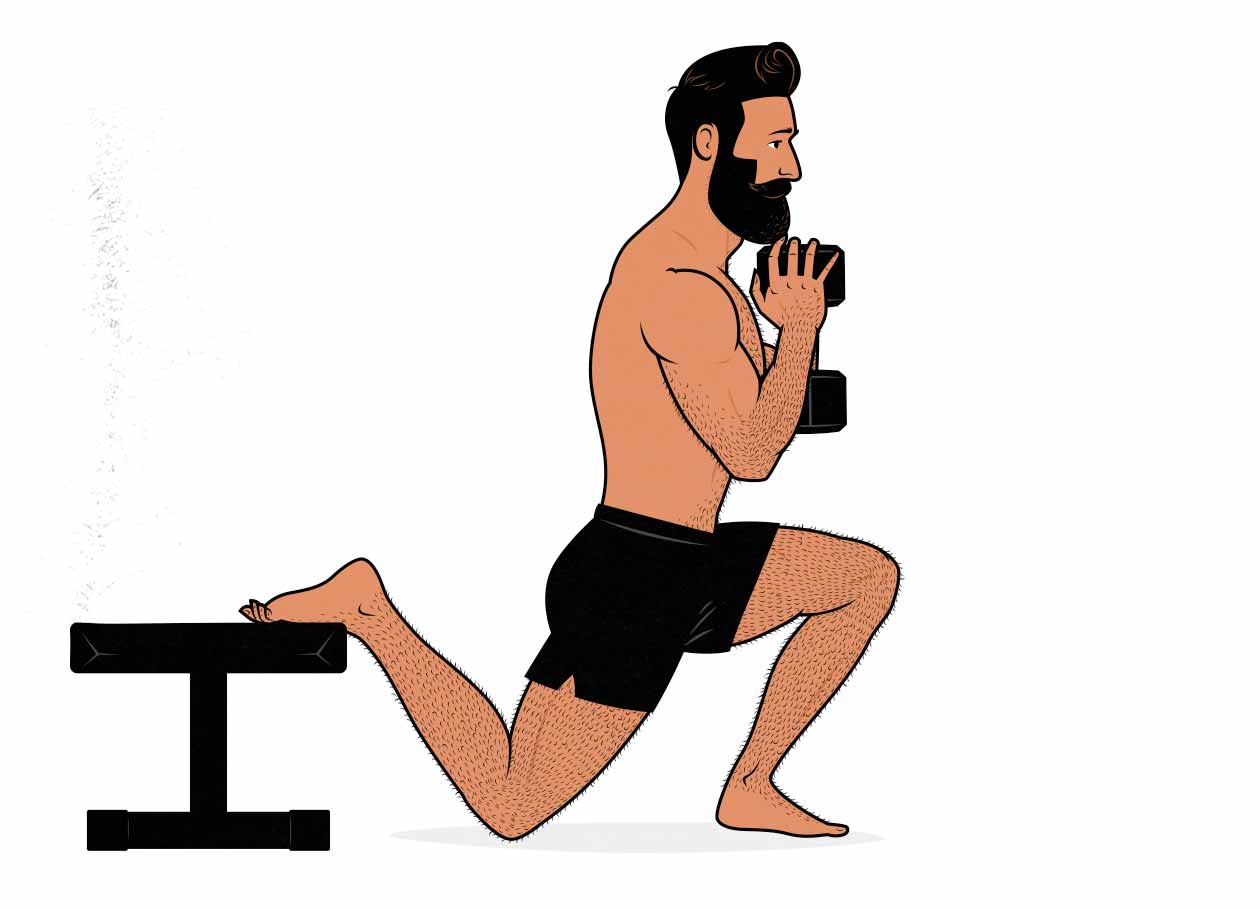
Workout 3
- Shoulder press (main lift): 10 sets of 10 repetitions with 60% of 1RM.
- Upright row (main lift): 10 sets of 10 repetitions with 60% of 1RM.
- Triceps pushdowns: 4 sets of 10 repetitions with 70% of 1RM.
- Biceps curls: 4 sets of 10 repetitions with 70% of 1RM.
- Sit-ups with twists: 3 sets of 20 repetitions to just shy of failure.
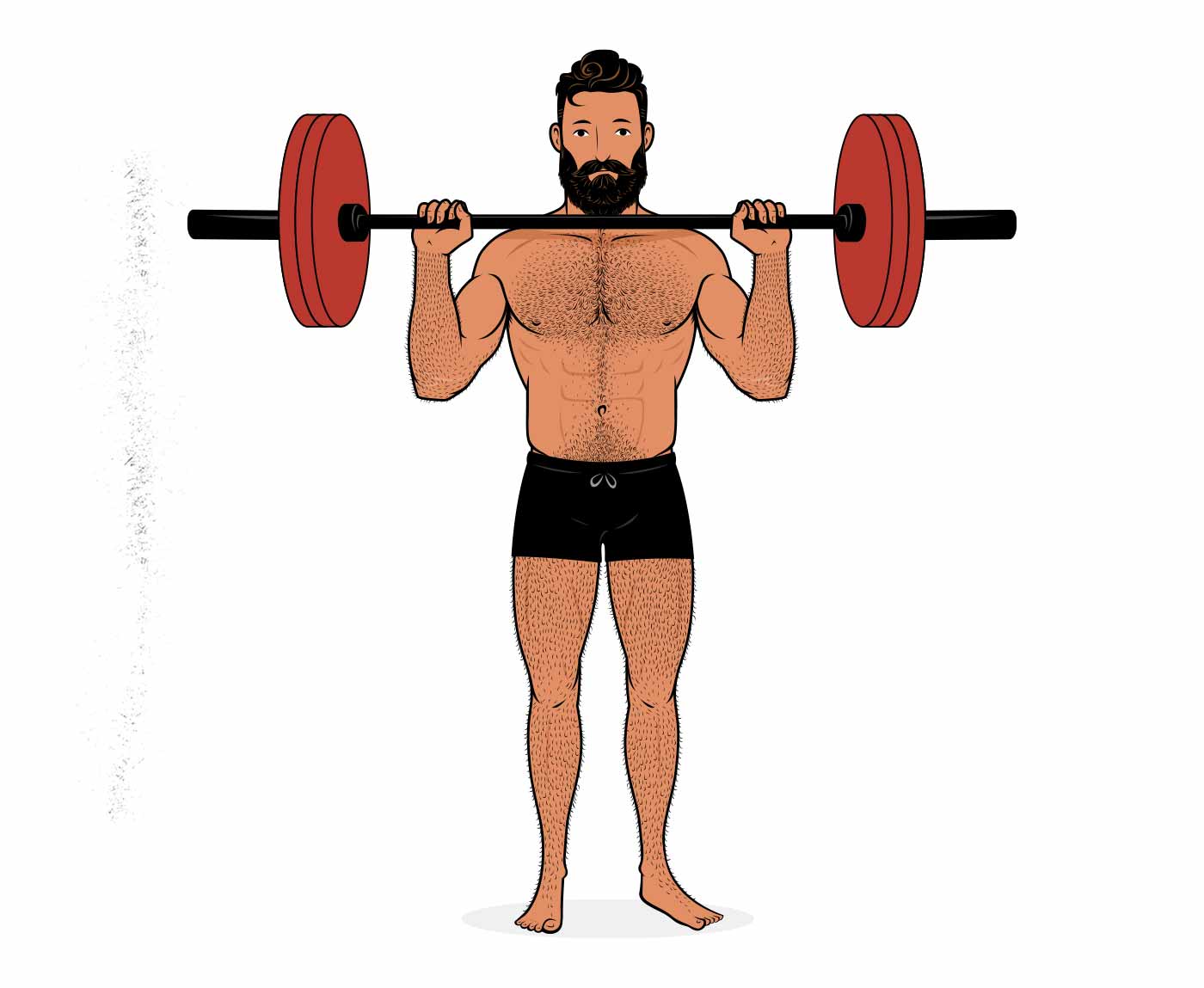
So what we have here is an upper/lower split workout routine. The first and third workouts focus on the upper body, and the second workout focuses on the lower body. Each muscle group is trained with a high volume each workout and then given at least four days to recover before being trained again.
The sets and reps are programmed in line with German Volume Training, with the main lifts being done for 10 sets of 10 repetitions and then the accessory lifts being done for 3–4 sets of 10–20 repetitions.
A wide variety of exercises are being used for each muscle. For instance, the triceps are being trained by the bench press, incline bench press, shoulder press, and triceps pushdowns. Some of these lifts bring the triceps close to failure, others don’t. The same is true for most other muscles, although some aren’t trained at all, such as our neck muscles, and some aren’t ever brought close to failure, such as our forearm muscles. That’s not necessarily a problem, though, depending on your goals. Some people don’t ever train their neck muscles.
Okay, now that we know what German Volume Training is what the workouts look like, let’s talk about whether it’s any good for building muscle.
Is German Volume Training a Good Way to Build Muscle?
Fortunately, there’s a high-quality study directly comparing German Volume Training against traditional hypertrophy training. The researchers had half the participants doing 10 sets of 10 repetitions, the other half doing 5 sets of 10 repetitions. After six weeks, their muscle growth, fat gains, and strength were measured.
It was a short study, and so not surprisingly, not all of the results were statistically significant. Even so, of all the differences that were statistically significant, the traditional hypertrophy training group outperformed the German Volume Training group. The group doing 5 sets gained more muscle mass in their chests, backs, and arms. They also saw greater improvements in their bench press and lat pulldown strength.
Now, there’s only so much we can infer from a single study. Fortunately, we have a second study comparing German Volume Training against traditional hypertrophy training. As with the first study, the results were quite similar between groups, with the main finding being that doing extra sets doesn’t stimulate extra muscle growth. However, it’s worth noting that the German Volume Training group started to lose muscle mass in their legs after the sixth week, perhaps because the participants were unable to recover from the high training volumes. They also gained less strength on the bench press, again presumably because they were having trouble recovering from their workouts. So at best, German Volume Training provides no benefit, and at worst, the extra sets impair our size an strength gains.
In both studies, the researchers concluded that muscle growth was maximized after 4–6 sets, at which point extra work stops yielding extra muscle growth. Doing more sets merely appears to make it harder to recover from our training. These recommendations are mirrored by the National Strength and Conditioning Association (NSCA).
Why Is Traditional Hypertrophy Training Better?
There’s nothing radical about doing sets of ten repetitions. In fact, doing ten reps per set is perfectly good for building muscle. It’s right smack in the middle of the hypertrophy rep range and is commonly used by bodybuilders. What separates German Volume Training apart from traditional hypertrophy training, as the name implies, is that it uses an especially high training volume.
There’s some logic to the idea of using higher training volumes to build muscle. Training volume is strongly linked with muscle hypertrophy, and so training with higher volumes will often lead to gaining extra muscle. There are a few ways that our training volume can be raised.
- One way to increase our training volume is to increase the number of reps per set. Moving from low reps (<6 reps per set) to moderate reps (6–20 reps per set) has been shown to increase muscle growth (study), and so if someone were switching from a 5×5 routine to a 5×10 routine, we’d expect them to gain more muscle.
- Doing more sets per lift per workout tends to increase muscle growth, with five sets per muscle group per workout tending to yield more muscle growth than doing just 1–3 sets (study).
- Doing more workouts per muscle per week tends to yield more muscle growth, with people training a muscle three times per week gaining more muscle than people training their muscles just once per week (meta-analysis).
However, there’s a point of diminishing returns. At a certain point, doing extra sets stops stimulating extra muscle growth. And eventually, the volume becomes more than we can recover from, diminishing our muscle growth. That’s the problem we run into with German Volume Training. After we’ve done 4–6 sets, we stop stimulating extra muscle growth with the extra sets.
The other problem with doing 10 sets per workout is that it increases muscle damage, extending the amount of time it takes to recover from our workouts. Instead of being able to train a muscle every 2–3 days, we need to wait 4–5 days before training it again. Muscle growth stops after 2–3 days, which means that we’re only growing for part of the week. That’s why low-frequency programs, such as push/pull/legs splits tend to be worse for stimulating muscle growth.
Summary
Traditional hypertrophy training is better than German Volume Training for stimulating muscle growth. By doing five sets instead of ten, we’d stimulate more muscle growth with less wear and tear on our joints, less muscle damage, less misery, and a lower risk of injury. Our workouts would become shorter and easier to recover from. And we wouldn’t lose anything.

German Volume Training has gone through phases of being popular, but by and large, the research doesn’t support it, most experts recommend against it, strength coaches are taught to avoid using it, and it’s so no longer widely used in strength or hypertrophy training. Now, just to be clear, that doesn’t mean that we shouldn’t ever use it or that there aren’t people who may benefit from it, just that for the average person, it’s a suboptimal way of training for muscle size and strength.

If you want a customizable workout program (and full guide) that builds these principles in, check out our Outlift Intermediate Bulking Program. Or, if you’re still skinny, try our Bony to Beastly (men’s) program or Bony to Bombshell (women’s) program. Our workouts include 3–6 sets per lift per workout, and we train our muscles multiple times per week. That allows us to efficiently accumulate more effective volume every week, increasing muscle growth.




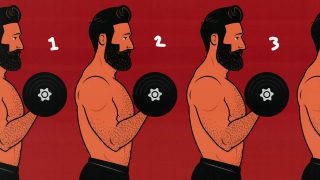

To say that GVT doesn’t work proves to me that your knowledge is woefully lacking. You have a degree is DESIGN. End of discussion.
I know you’re saying “end of discussion,” but I think we learn more when we discuss things. You’re totally free not to respond. I won’t mind.
I didn’t say that GVT doesn’t work. It does. I just said that GVT doesn’t work as well as other conventional methods of hypertrophy training.
If you look at the authors of the article, you’ll see that Marco has a degree in health sciences. He also studied under Eric Cressey, they head strength coach for the New York Yankees. And back before we created this business, when Marco was running his personal training business, he was helping college, professional, and Olympic athletes bulk up. I’m not sure that’s required, though, since we aren’t relying on our credentials to make our arguments.
Please consider your ability to recover. German Volume may result in overtraining in a 45 year old where it may not in a seasoned 22 year old. In my experience, with proper recovery, there has been no effective mass-building program when paired with a single compound lift such as one of the following: trap bar deadlift, clean & press, etc.
I should also mention that this method was so effective for me that it took me from 150 lbs to 250 lbs in a matter of a few years, perhaps there was a more effective way to get there?? Unknown, however I can testify that GVT worked wonders for me and is still a part of my programming today.